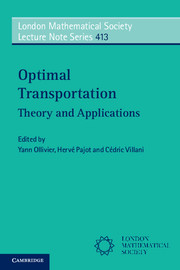Book contents
- Frontmatter
- Contents
- List of contributors
- Preface
- PART 1 SHORT COURSES
- PART 2 SURVEYS AND RESEARCH PAPERS
- 8 Computing a mass transport problem with a least-squares method
- 9 On the duality theory for the Monge–Kantorovich transport problem
- 10 Optimal coupling for mean field limits
- 11 Functional inequalities via Lyapunov conditions
- References
8 - Computing a mass transport problem with a least-squares method
from PART 2 - SURVEYS AND RESEARCH PAPERS
Published online by Cambridge University Press: 05 August 2014
- Frontmatter
- Contents
- List of contributors
- Preface
- PART 1 SHORT COURSES
- PART 2 SURVEYS AND RESEARCH PAPERS
- 8 Computing a mass transport problem with a least-squares method
- 9 On the duality theory for the Monge–Kantorovich transport problem
- 10 Optimal coupling for mean field limits
- 11 Functional inequalities via Lyapunov conditions
- References
Summary
Abstract
This work originates from a heart's image tracking, generating an apparent continuous motion, observable through intensity variation from one starting image to an ending one, both supposed segmented. Given two images ρ0 and ρ1, we calculate an evolution process ρ (t, ·) which transports ρ0 to ρ1 by using the extended optical flow. In this chapter we propose an algorithm based on a fixed-point formulation and a space-time least-squares formulation of the mass conservation equation for computing a mass transport problem. The strategy is implemented in a 2D case and numerical results are presented with a first-order Lagrange finite element.
Introduction
Modern medical imaging modalities can provide a great amount of information to study the human anatomy and physiological functions in both space and time. In cardiac magnetic resonance imaging (MRI), for example, several slices can be acquired to cover the heart in 3D and at a collection of discrete time samples over the cardiac cycle. From these partial observations, the challenge is to extract the heart's dynamics from these input spatio-temporal data throughout the cardiac cycle [10, 12].
Image registration consists in estimating a transformation which insures the warping of one reference image onto another target image (supposed to present some similarity). Continuous transformations are privileged; the sequence of transformations during the estimation process is usually not much considered. Most important is the final resulting transformation, not the way one image will be transformed to the other. Here, we consider a reasonable registration process to continuously map the image intensity functions between two images in the context of cardiac motion estimation and modeling.
The aim of this chapter is to present, in the context of extended optical flow (EOF), an algorithm to compute a time-dependent transportation plan without using Lagrangian techniques.
- Type
- Chapter
- Information
- Optimal TransportTheory and Applications, pp. 203 - 215Publisher: Cambridge University PressPrint publication year: 2014

